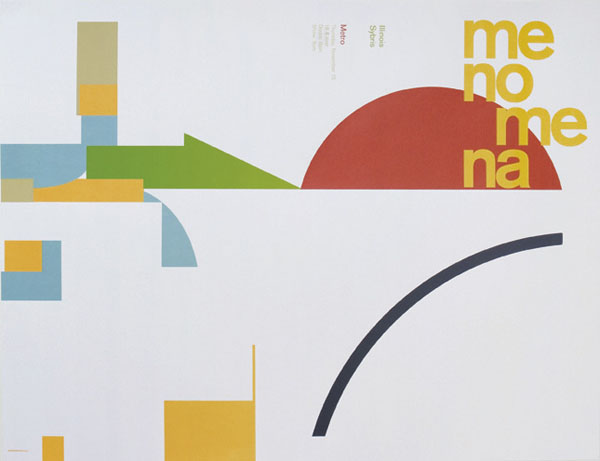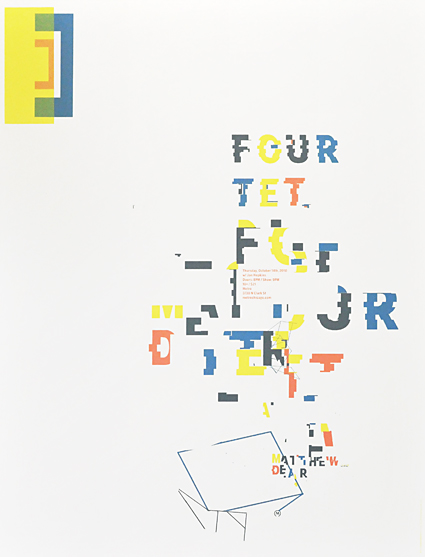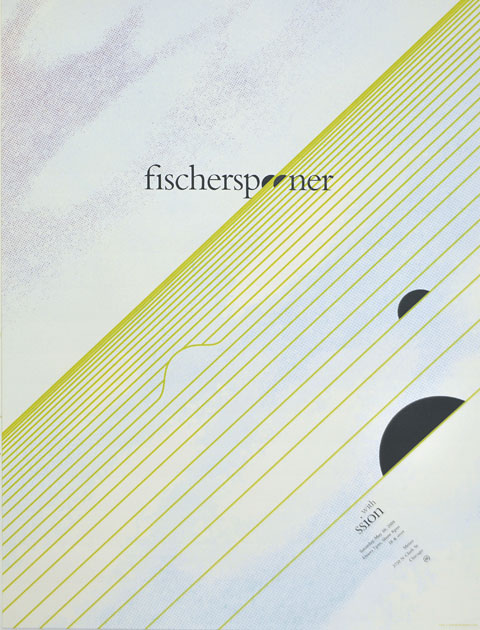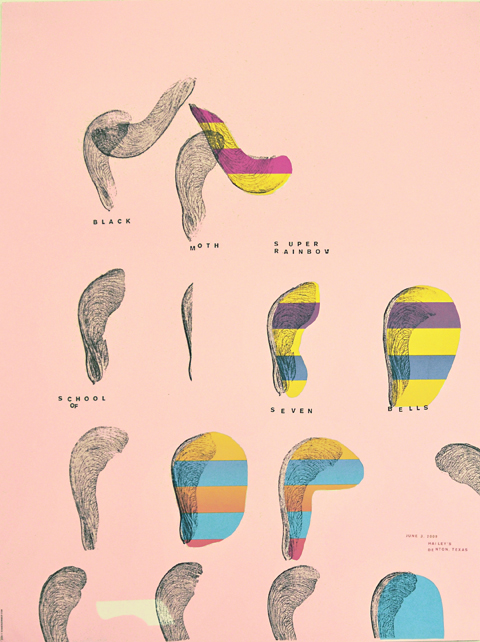“I know this doesn’t look spectacular, but I would say that we have kind of this eclectic set up,” Nadine Nakanishi says as she pours a cup of San Pellegrino for me while showing me around the Sonnenzimmer screen-printing studio. “Depending on what we are doing, the furniture kind of gets a different constellation.”
Sonnenzimmer definitely is an eclectic, quaint little shop that peeks out from a quiet alley off Damen Avenue in Chicago’s Roscoe Village neighborhood. Its mishmash of secondhand, vintage lamps and portable tables made out of disassembled doors help to create the space’s inviting atmosphere, but the studio’s industrial-grade hand-press and exposure unit truly make Sonnenzimmer unique.
The studio started in 2006 when Nakanishi and her boyfriend of five years, Nick Butcher, merged their painting studios. Over the past three years, their venture has flourished into a well-respected studio that has left its mark on Chicago’s screen-printing community.

In borrowing from the hand-drawn, DIY style honed by Steve Walters of Screwball Press and combining it with the precision of a screen-printing press, they have created a unique hybrid that stands out within Chicago’s gig-poster community. “We’ve gotten into the technical aspect with this equipment,” Butcher says. “It has allowed us to do finer details, and we could start experimenting with weird textures, really precise registration, and stuff that I would just avoid before.”
When it comes to creating posters, instead of taking the traditional figurative approach that is synonymous with some of the city’s most recognizable screen-printers, they have veered into the abstract realm and in the process have created a look that is distinctly their own. “For me, what helped was diving into improvised music here,” Nakanishi says, “and being really able to go down the abstract route. [Other Chicago-based screen-printers] are very at home in the figurative lobby, and I always felt intimidated because I was like, ‘Well, I can draw, kinda’ but never remotely as good as they could.”

Over the years, the two have created posters for Chicago staples like The Sea and Cake and international bands like Tokyo Police Club. The couple has also created work for a number of local musicians such as oRSo, Tim Daisy, Vox Arcana, and Male — an experimental band that counts Butcher as a member. They have mastered the ability to create posters that aren’t necessarily visually loud but that grab attention from across the room. “Our general approach is making space for quietness so that you can come close and engage,” Nakanishi says, “so that it’s not unanimous from a visual communication point. We offer a certain smallness and a little bit of room for interpretation.”
Yet if it wasn’t for some random guy standing in the corner at a house show, Sonnenzimmer might not be what it is today. Three years ago, Butcher remembers playing a solo show at “this really tiny house show, and there was this one older guy there…”
“Alone in the corner!” Nakanishi interjects.
“He wasn’t creepy,” Butcher says. “He was just like, ‘I’m here at this show because I like weird, experimental music. All you other people obviously know each other and that’s cool.’”
“Our general approach is making space for quietness so that you can come close and engage. We offer a certain smallness and a little bit of room for interpretation.”
Butcher struck up a conversation with the guy in the corner, Bruce Wood. As fate would have it, the topic of screen-printing came up, and Wood mentioned that he ran a press and was planning to sell his equipment, and that they should come check it out. They decided to take him up on his offer, and when they arrived at his warehouse, they were completely blown away. “It was industrial screen-printing stuff, and we were like, ‘Holy shit! What is this stuff?’” Butcher says. “And he said, ‘It’s like any other screen-printing stuff; you’ll figure it out.’
“Basically, when we printed,” Nakanishi adds, “we just had glass and construction lights that were hooked up to a kitchen clock, and that’s the way that a lot of gig posters were made.”
Within the DIY/punk scene, screen-printed gig posters were one of the cheapest and most accessible ways for local bands to promote their shows.
“I think that historically, it was people who were doing it themselves, and they were self-taught, doing this in their kitchen,” Butcher says. The local music scene heavily influenced the screen-printing community, which basically grew out of “nice people making posters for their friend’s bands,” says Jay Ryan, the owner of Chicago poster workshop The Bird Machine and a member of local rock trio Dianogah.

It was the DIY ethos and the sense of taking creative work seriously that led Butcher and Nakanishi to make the Windy City their new hometown. Even though they came to the city from opposite ends of Earth, their paths converged in Chicago in a way that only happens when stars align.
Butcher’s initial interest in screen-printing came from an unlikely source. “I was in a Boy Scout troop…” he starts.
“I haven’t heard this one before!” Nakanishi says as she starts laughing.
While at camp, one of the Scout leaders’ shirts caught Butcher’s eye. When Butcher asked him where he got it, the Scout leader told him it was screen-printed. “I was like, ‘Whoa, you can make your own shirts?’” Butcher says. “So I always had it in the back of my head: ‘What is this screen-printing?’”
As a graphic-design student at Middle Tennessee State University, Butcher spent most of his free time in the screen-printing department and planned to move to Chicago after graduation. Ryan was a heavy influence on his work, and it was Butcher’s dream to intern at The Bird Machine. “I got a lot of requests for people to be interns, and it just never seemed like a good idea,” Ryan says. “Then I get this e-mail from this one guy in Tennessee who I never met…but it was something about the images that he sent and his tone that seemed like a good idea.” So Butcher packed up and relocated to Chicago, and everything basically fell into place. “I interned with Jay and met a bunch of other printmakers in Chicago,” Butcher says, “and it just kind of rolled from there.”
“What about you?” he asks as he turns towards his girlfriend.

Nakanishi’s journey to Chicago spans continents. Originally from California, her family moved to Switzerland when she was a teenager. She became interested in Switzerland’s design and poster culture, which was engrained in the national consciousness. As a typography student at Berufsschule für Gestaltung Zürich, she developed a precise, modernist approach that is synonymous with Swiss design. “Poster culture is very prestigious,” Nakanishi says.
“It has to do with the cultural education. It’s political; it has really formed Swiss identity in the design world. You couldn’t just be there and be like, ‘I want to be a rock-star artist,’ because the poster world just isn’t conceived that way.”
Yet even from 4,000 miles away, she was still fluent in Chicago’s DIY/punk scene via Punk Planet magazine. In 2003, she also decided to make a go of it in Chicago and sent an e-mail to Punk Planet’s founder, Dan Sinker. “Suddenly, there is this e-mail from this woman in Switzerland,” Sinker says, “and she’s like, ‘I want to come to Chicago and do an internship with Punk Planet.’ I had to write back and be like, ‘Okay, we can’t pay you, and we can‘t put you up, but if you want to come out, we’d love to have you.” A few months later, Nakanishi was living in Chicago.
Butcher and Nakanishi initially met during their interning days because Punk Planet and The Bird Machine split an office space. Working with their mentors allowed the two to flourish and really come into their own. Butcher continued to hone the techniques that Ryan had passed on to him. “Nick has really become a master of taking screen-printing as a process, and he treats each print as though it were a painting,” Ryan says.

Nakanishi found a medium between her rigorous design education and the DIY mentality that she admired. Those around her started taking notice. “She came from the most rigorous design education that you can get,” Sinker says, “where there is literally no such thing as unintentional design or happy accidents. She would get so stressed out about designs, and we would be like, ‘That’s fantastic.’ You can clearly see that her work now is much looser than she was before and that she understands that there is a certain serendipity to this stuff…but it’s still very Swiss.”
Being in Chicago among fellow poster artists like Mat Daly, Dan Grzeca, and Diana Sudyka showed Butcher and Nakanishi how to blend the local aesthetic into their work, but being around each other showed them how to make their style all their own.
“I think that what sets them apart is their color palette, their design sense,” Daly says. “There is something very handmade about their images. It’s a very interesting combination.”
In many ways, they balance one another out. Butcher was fascinated by the clean, modernist technique synonymous with Swiss design and was influenced by Nakanishi’s minimalist approach. She, on the other hand, looked to Butcher to center her if she overthinks an image from a conceptual standpoint.

“I have felt most proud of the stuff that we did together because she has a really hardcore typography background,” Butcher says, “whereas I come from more of a printmaking background. When those two are combined, it’s just more compelling than the stuff that we were doing individually.” And their styles have become so intertwined that they have begun to forge a niche within Chicago’s printing community. “[Their styles] are deceptively similar,” says Ryan Kapp, another lauded Chicago-based artist. “But in getting to know them, I think that’s why their posters really mesh well together.”
Butcher and Nakanishi are incredibly grateful to those in Chicago’s screen-printing community who have taken them under their wing, and they want to continue to foster that sense of community. While Butcher was visiting some friends in Austin, he decided to work on a fine-art print series in their studio.
Inspired by his experiences, he wanted to try a similar concept at Sonnenzimmer. As a result, he and Nakanishi created the Art Print Series and invited their fellow artist friends to use the studio for a week to create a custom art print. “I guess the overall idea was to open up the studio and make this more than just our screen-printing studio, and make it have more of a community feel,” Butcher says. “Which I think we did because at the end of the first series, we were able to have an exhibit.” Although the series is currently on hiatus while they figure out the long-term logistics, the two plan to continue finding ways to foster a sense of camaraderie. “We want to give back like Punk Planet and Bird Machine did for us,” Nakanishi says.

